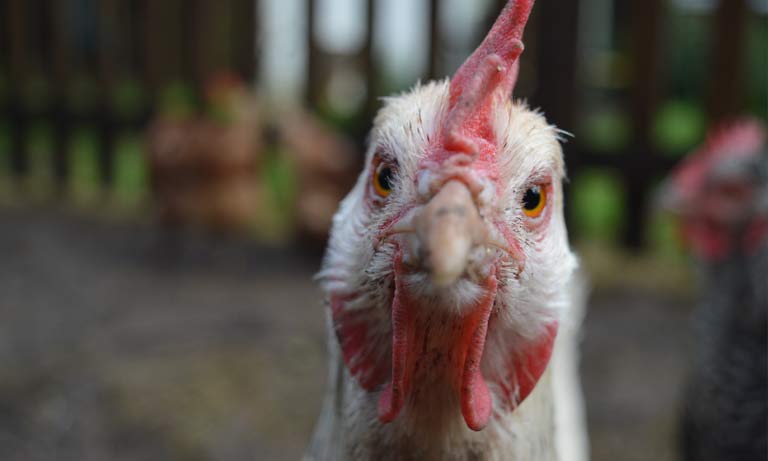Feather pecking in laying hens
What's the issue?
Feather pecking, where birds peck at the feathers of other birds, sometimes pulling them out and eating them, is a significant welfare issue in poultry keeping.
The health and welfare of the affected birds is greatly compromised, and the physical, and therefore financial, losses can be great. Feather pecking can cause:
- Pain and stress, which can increase the susceptibility of the flock to disease and could directly lead to spread of a disease throughout the flock through pecks on damaged skin.
- Poor plumage and patches of feather loss, resulting in reduced productivity and increased food consumption in defeathered birds, contributing to financial losses. Loss of the protective function of the bird’s plumage may also lead to discomfort.
- Skin damage, leaving the bird more susceptible to other infections and disease.
- Death, where feather pecking develops into injurious pecking that can trigger cannibalism.
Once feather pecking becomes prevalent in a flock it can be extremely difficult to stop and, if the behaviour becomes severe and leads to cannibalism, it may result in the need to cull large numbers of birds.
Feather pecking is considered to be most prevalent in laying hens and whilst the majority of animals affected will be in the commercial sector, our position may also be relevant to non-commercial (‘backyard’) poultry keepers.
As a precautionary measure, it is standard practice to blunt beaks to prevent the development of the sharp hook on the beak of adult birds. This is referred to as ‘beak trimming’ in legislation, but is more widely referred to as ‘beak treatment’ in industry and practice. This reduces the injuries and mortality rate caused by feather pecking, but does not prevent the abnormal behaviour from occurring.
The UK veterinary profession, in collaboration with the poultry industry is leading the way on solutions to the issue, but challenges remain.

What's our view?
Prevention and management of feather pecking are essential goals, given the impact on animal health and welfare. Although feather pecking cannot be eliminated, optimising management practices can reduce the frequency and likelihood of this behaviour, thereby improving welfare.
All vets in practice should familiarise themselves with a basic understanding of how to reduce and manage feather pecking, and sector experts should share their knowledge widely. Poultry keepers and veterinary surgeons should understand the risk factors associated with feather pecking, be able to identify an outbreak, and know what immediate steps to take in response to an outbreak.
We would like to see the industry move away from routine beak treatment once feather pecking behaviours are effectively managed. Poultry keepers should work to reduce feather pecking behaviours even when birds’ beaks have been treated, and retailers, governments, industry and key stakeholders must work together to find better management solutions.
Feather pecking is a complex problem and very unpredictable. Our position makes recommendations related to the management of the following factors, which can make a difference:
- Bird temperament
- Health
- The transition from rearing to laying accommodation
- Housing design and layout
- Lighting
- Diet and foraging
- Variation in bird weights
- Environmental enrichment
- Keeper knowledge and management
Any sudden change in environment or management can lead to an outbreak of injurious pecking, so poultry keepers should monitor welfare of birds closely and implement management changes where necessary, in close liaison with a veterinary surgeon.
Read our policy documents
Get involved
- Contact our policy team for more information.
- Contact BVPA for expert advice on caring for poultry.
